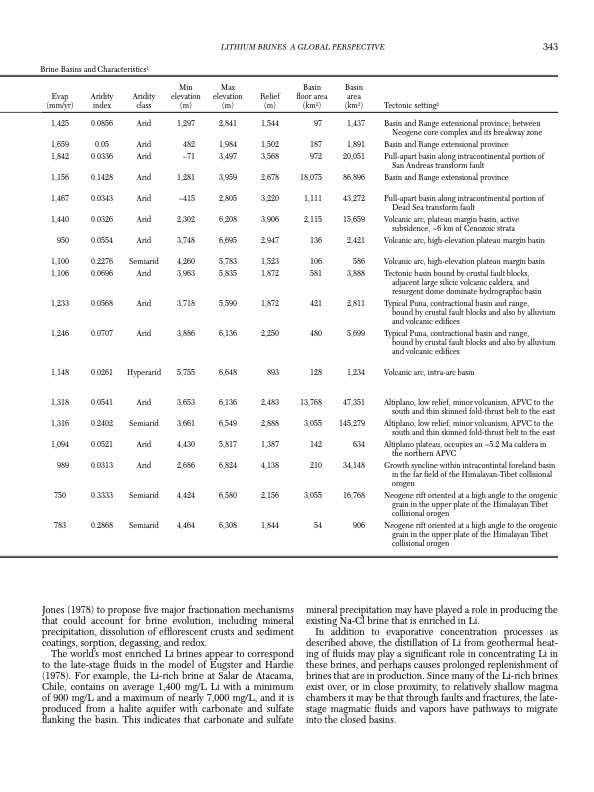
PDF Publication Title:
Text from PDF Page: 005
Brine Basins and Characteristics1 Evap Aridity (mm/yr) index 1,425 0.0856 1,659 0.05 1,842 0.0336 1,156 0.1428 1,467 0.0343 1,440 0.0326 Aridity class Arid Arid Arid Arid Arid Arid Arid Min Max elevation elevation (m) (m) 1,297 2,841 482 1,984 –71 3,497 1,281 3,959 –415 2,805 2,302 6,208 3,748 6,695 4,260 5,783 3,963 5,835 3,718 5,590 3,886 6,136 5,755 6,648 3,653 6,136 3,661 6,549 4,430 5,817 2,686 6,824 4,424 6,580 4,464 6,308 Relief (m) 1,544 1,502 3,568 2,678 3,220 3,906 2,947 1,523 1,872 1,872 2,250 893 2,483 2,888 1,387 4,138 2,156 1,844 Basin Basin floor area area (km2) (km2) 97 1,437 187 1,891 972 20,051 18,075 86,896 1,111 43,272 2,115 15,659 136 2,421 106 586 581 3,888 421 2,811 480 5,699 128 1,234 13,768 47,351 3,055 145,279 142 634 210 34,148 3,055 16,768 54 906 Tectonic setting2 Basin and Range extensional province; between Neogene core complex and its breakway zone Basin and Range extensional province Pull‐apart basin along intracontinental portion of San Andreas transform fault Basin and Range extensional province Pull‐apart basin along intracontinental portion of Dead Sea transform fault Volcanic arc, plateau margin basin, active subsidence, ~6 km of Cenozoic strata Volcanic arc, high-elevation plateau margin basin Volcanic arc, high-elevation plateau margin basin Tectonic basin bound by crustal fault blocks, adjacent large silicic volcanic caldera, and resurgent dome dominate hydrographic basin Typical Puna, contractional basin and range, bound by crustal fault blocks and also by alluvium and volcanic edifices Typical Puna, contractional basin and range, bound by crustal fault blocks and also by alluvium and volcanic edifices Volcanic arc, intra‐arc basin Altiplano, low relief, minor volcanism, APVC to the south and thin skinned fold‐thrust belt to the east Altiplano, low relief, minor volcanism, APVC to the south and thin skinned fold‐thrust belt to the east Altiplano plateau, occupies an ~5.2 Ma caldera in the northern APVC Growth syncline within intracontintal foreland basin in the far field of the Himalayan‐Tibet collisional orogen Neogene rift oriented at a high angle to the orogenic grain in the upper plate of the Himalayan Tibet collisional orogen Neogene rift oriented at a high angle to the orogenic grain in the upper plate of the Himalayan Tibet collisional orogen 1,106 0.0696 1,233 0.0568 1,246 0.0707 1,148 0.0261 1,318 0.0541 1,316 0.2402 Semiarid 1,094 0.0521 989 0.0313 Arid Arid 750 0.3333 Semiarid 783 0.2868 Semiarid Arid Arid Arid Hyperarid Arid LITHIUM BRINES: A GLOBAL PERSPECTIVE 343 950 0.0554 1,100 0.2276 Semiarid Jones (1978) to propose five major fractionation mechanisms that could account for brine evolution, including mineral precipitation, dissolution of efflorescent crusts and sediment coatings, sorption, degassing, and redox. The world’s most enriched Li brines appear to correspond to the late-stage fluids in the model of Eugster and Hardie (1978). For example, the Li‐rich brine at Salar de Atacama, Chile, contains on average 1,400 mg/L Li with a minimum of 900 mg/L and a maximum of nearly 7,000 mg/L, and it is produced from a halite aquifer with carbonate and sulfate flanking the basin. This indicates that carbonate and sulfate mineral precipitation may have played a role in producing the existing Na‐Cl brine that is enriched in Li. In addition to evaporative concentration processes as described above, the distillation of Li from geothermal heat- ing of fluids may play a significant role in concentrating Li in these brines, and perhaps causes prolonged replenishment of brines that are in production. Since many of the Li‐rich brines exist over, or in close proximity, to relatively shallow magma chambers it may be that through faults and fractures, the late‐ stage magmatic fluids and vapors have pathways to migrate into the closed basins.PDF Image | Lithium Brines A Global Perspective

PDF Search Title:
Lithium Brines A Global PerspectiveOriginal File Name Searched:
14_Munketal.pdfDIY PDF Search: Google It | Yahoo | Bing
Product and Development Focus for Infinity Turbine
ORC Waste Heat Turbine and ORC System Build Plans: All turbine plans are $10,000 each. This allows you to build a system and then consider licensing for production after you have completed and tested a unit.Redox Flow Battery Technology: With the advent of the new USA tax credits for producing and selling batteries ($35/kW) we are focussing on a simple flow battery using shipping containers as the modular electrolyte storage units with tax credits up to $140,000 per system. Our main focus is on the salt battery. This battery can be used for both thermal and electrical storage applications. We call it the Cogeneration Battery or Cogen Battery. One project is converting salt (brine) based water conditioners to simultaneously produce power. In addition, there are many opportunities to extract Lithium from brine (salt lakes, groundwater, and producer water).Salt water or brine are huge sources for lithium. Most of the worlds lithium is acquired from a brine source. It's even in seawater in a low concentration. Brine is also a byproduct of huge powerplants, which can now use that as an electrolyte and a huge flow battery (which allows storage at the source).We welcome any business and equipment inquiries, as well as licensing our turbines for manufacturing.| CONTACT TEL: 608-238-6001 Email: greg@infinityturbine.com | RSS | AMP |